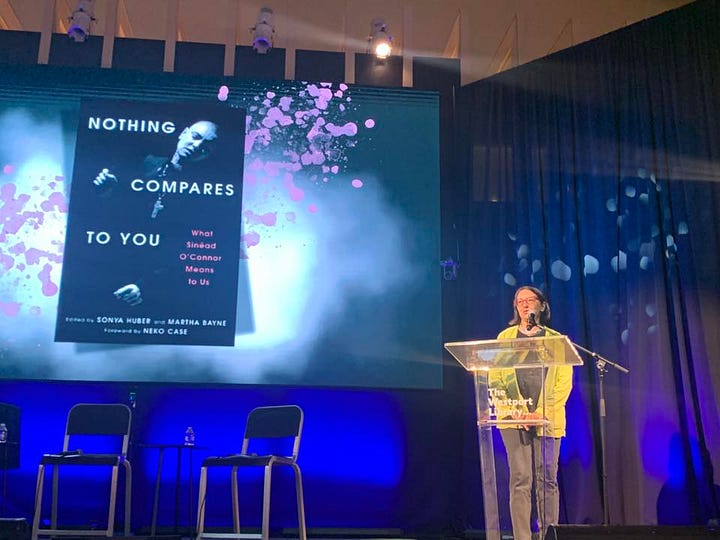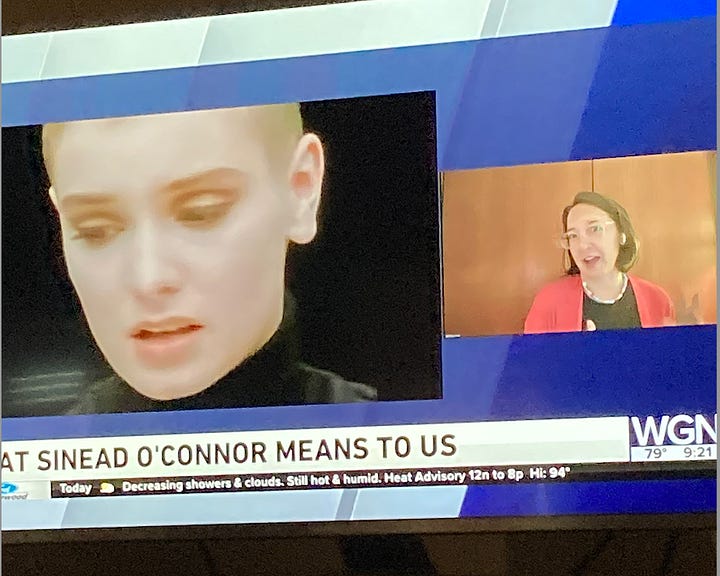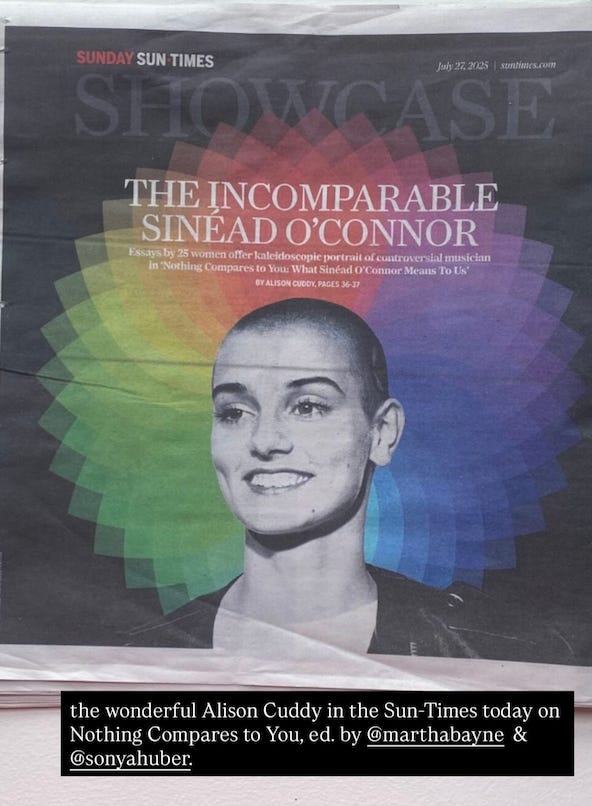



Today we have a beautiful original essay by Tamara MC, “The Night Sinéad O’Connor Found Me in a Convertible.”
Past entries in this series:
’s original essay, “To Mother You”
Jerry Portwood’s original essay, “Her Eyes Are My Beacon, Her Voice My Guide”
Rebecca Kuder’s original essay, “Everywhere is War.”
Noah Berlatsky’s “Sinéad O’Connor’s ‘I Do Not What What I Haven’t Got’ speaks to the fight against Trump from 27 years in the past,” which originally appeared in the Chicago Reader.
Aimee Seiff Christian’s essay “I loved Sinéad for her wild courage and rage,” which originally appeared on WBUR’s Cognoscenti.
Shawna Kenney’s original essay, “Feel So Different.”
’s essay “Stretched on Her Grave” which originally appeared on her Substack, Off the Record.
April Nance’s original essay, “Sinéad and Barbie and Me.”
Emily J. Orlando’s original essay, “‘You Asked for the Truth and I Told You’: For Sinéad”
Eileen Toomey’s “In Defense of Sinéad O’Connor,” which originally appeared in The Rumpus.
Jocelyn Jane Cox’s essay “Sinéad O’Connor Helped Me Find My Voice,” which originally appeared in in Sari Botton’s
.
Jeff Dorchen’s essay “Ketch Vampire”
Erika Meitner’s poem “Sinéad O’Connor Was Right All Along,” which originally appeared in LitHub.

The Night Sinéad O’Connor Found Me in a Convertible
I was babysitting the first time I experienced Sinéad O’Connor. The dad was driving me home in his red convertible through the Arizona midnight, my hair whipping in the warm wind, that feeling of freedom that comes with being 15 and flying through darkness. Drakkar Noir filled the air. The radio was playing something forgettable when suddenly her voice emerged—raw, unadorned. “Troy” filled the car with its building intensity, while I pressed my palm against the leather seat, feeling the vibration of bass through my hand, through my bones.
Something in the voice, a particular resonance of pain transformed into sound, spoke directly to the part of me that had survived, though I couldn’t have named it then. It was 1987. Chernobyl’s nuclear reactor had exploded, radiation spreading across Europe. The space shuttle had burst into flames with a teacher inside, her students watching on live TV. AIDS was spreading through silence and shame while those in power refused to speak its name.
I earned babysitting money on Saturday nights, my life split between my mother in Arizona and my father who’d joined a cult in Texas. The cult used scripture to control girl’s movements, to restrict their education, to justify marrying them to grown men. Holy verses twisted into chains.
The summer after 7th grade brought a different kind of education. Two months past my first period, the leader’s adopted son who’d violated me decided marriage would sanctify his crimes. A ceremony conducted in minutes—him speaking words I had to repeat without understanding their full weight. This temporary religious marriage would stretch through eight years, through high school hallways where I kept secrets, through summers returning to Texas. When I returned to my mother in Tucson that August, I told her nothing. The marriage remained hidden, a secret that would grow heavier each year.
Sinéad’s voice that night wasn’t just singing; it was testimony. Years later I’d learn the details—how her devoutly Catholic mother beat her while keeping the Pope’s photo on the wall, how she’d been sent to a Magdalene laundry as a teenager where girls were punished for existing, how she’d survived sexual abuse that the Church covered up. Religion weaponized against children’s bodies. But that night in the convertible, I knew none of these facts. I only sensed that voice carried the specific tone of someone hurt young by people who were supposed to protect her, faith turned into a tool of control. Two people who had survived recognizing each other across the radio waves. Her voice carried knowledge I recognized but couldn’t name.
The dad shifted gears as we climbed the hill toward my neighborhood. For those few minutes in his convertible, I felt what freedom might be like—wind in my hair, the night wide open, a voice on the radio that understood things I’d never told anyone. The song faded as we turned onto my street. In my room that night, Sinéad’s voice echoed in my head—testimony.
Years passed. I kept secrets through high school while classmates worried about SATs and boyfriends. Summers meant Texas. School years meant silence. The marriage stretched on while I moved through hallways trying to remain invisible, my mother never knowing why her daughter had gone quiet.
When “Nothing Compares 2 U” arrived, I watched it while babysitting, since we didn’t have MTV at home—my mother and I were poor, cable was a luxury we couldn’t afford. Babysitting meant money but also meant access to the wider world through other people’s television sets. The camera held Sinéad’s face in merciless close-up for the entire video. Her shaved head and enormous eyes filled the frame while tears tracked down her cheeks. She broke every rule about how women should present pain. The video was inescapable and mesmerizing—raw emotion without apology, grief that she made beautiful.
For Gen X girls learning to swallow our rage, here was proof it could be transformed into art.
Sinéad’s shaved head changed everything. In the cult, I had to cover my hair, my long locks hidden under fabric while being told they were too beautiful, too tempting to show. Hair was woman’s glory, they said, meant to be controlled, contained, hidden. Then here was Sinéad refusing the entire system—not cutting her hair short or styling it differently but removing it completely from the conversation.
By then I was nineteen, in my seventh year of marriage. My husband had taken a second wife—polygamy had entered the picture, and I watched him love her. The possibility of leaving began to flicker at the edges of my vision. How to escape remained unclear—just the idea forming slowly. Within a year, I would find a way out. I was living internationally and managed to return to the United States, never going back. The temporary marriage would dissolve on its own. The emotional untangling would take years.
After I escaped, the silence deepened. Moving through my twenties, I had no way to name what had happened—those years in Texas locked away where language couldn’t reach. While Sinéad transformed pain into music in her twenties, crafting art from fresh wounds, I needed years before I could form sentences around what happened. Some women sing immediately because that’s their survival. Others carry silence for decades.
Life layered over trauma—college, career, marriage to someone I chose, children, divorce. The story lived in my body. I was 48 when I finally found words for what happened—the same age Sinéad was when they took her womb. Something about that parallel haunted me. Both of us, at the same age, forced to reckon with what had been taken.
When Sinéad died at 56, I was 51, my own body beginning its transformation. A year later, I would cross into menopause—that line between bleeding and not bleeding, between fertile and not. Reading about her hysterectomy, how they sent her home with painkillers and no hormones, I recognized another kind of violation. She’d been pushed into this change before her body was ready, the way she’d been pushed into so much else.
But that night in 1987, flying through the Arizona darkness, I knew none of this future. My body was still new to bleeding, still years from understanding what people had stolen from me. Sinéad’s voice broke through radio static and engine noise while the Drakkar Noir mixed with desert air, my hair wild and free while everything else remained locked away.
Two survivors, one calling across the night to another. Not demanding immediate response. Not insisting on any timeline.
That was enough to carry me through.
Link to original article
